"By playing checkers on concrete, we can effectively avoid the large temperature difference and shrinkage in the early stage of concrete construction, and there is no need to leave post-cast strip." Lin Qiang, head of the project in Area C of the Southern Headquarters Base of the Fourth Navigation Bureau, proudly introduced to the visitors.
The Southern Headquarters Base Area C Project is located near the Pearl River in Haizhu District, Guangzhou, with a total construction area of more than 200,000 square meters, a total building height of 154.9 meters, 31 floors above ground and 3 floors underground. Among them, the basement area is 37000 square meters, which is equivalent to the size of five standard football fields. The excavation of the foundation pit is 300 meters long and 130 meters wide, which is a super-long and super-wide concrete structure. The winter in Guangzhou is wet and cold, so the project construction not only has to face the impact of humid and cold air, but also has to face the great challenge of "resisting" the temperature stress and shrinkage tension of concrete materials.

The super-long and super-wide concrete structure is prone to deformation and cracks, and it is not feasible to rely solely on the traditional "resistance" method in concrete pouring. After several considerations, the project team took into account the scheme of setting up the post-pouring belt for construction. The post-cast strip is a concrete strip reserved with a certain width and poured after a period of time to prevent the uneven shrinkage or settlement of the reinforced concrete structure itself. However, the super-long concrete structure of the project will lead to too many post-cast strips, which are difficult to clean up in the later stage and prone to cracks, resulting in cracking and seepage of the basement. At this time, the overall construction progress of the basement has been delayed compared with the original plan, so it is urgent to improve the construction efficiency.
Aim at the "pain point" and make precise efforts. Li Jingfeng, the chief engineer of the project, led the technical team to tackle the key problems with the idea of "resisting and releasing simultaneously", "releasing first and then resisting" and "giving priority to resisting", and used the principle of "resisting and releasing" which is easy to release the internal stress of concrete before its performance is not stable and completely solidified in 5 to 10 days, and adopted the "jumping warehouse method" for construction. The basement foundation, wallboard and roof are divided into 21 blocks according to 30 construction joints. According to the block division, one block is poured at an interval.
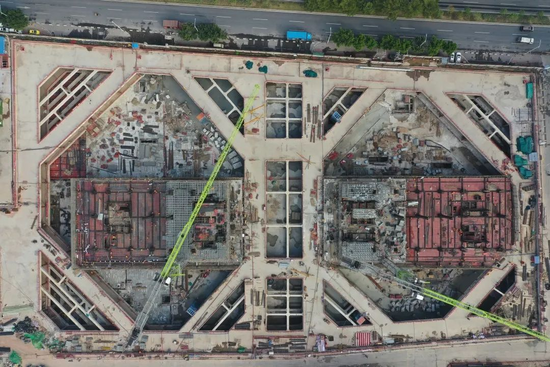
"Jumping method" pouring not only reduces 1200 meters of post-pouring belt, ensures the integrity of basement floor, but also avoids the cost of construction joint cleaning and expansion reinforcement belt pouring concrete, so we have a good chance to win the chess game. Lin Qiang looked at the construction progress and said with a smile. After accounting, the "jump warehouse method" was adopted to construct the basement floor, which saved nearly 600000 yuan.
What is the "jump method"? Example
of
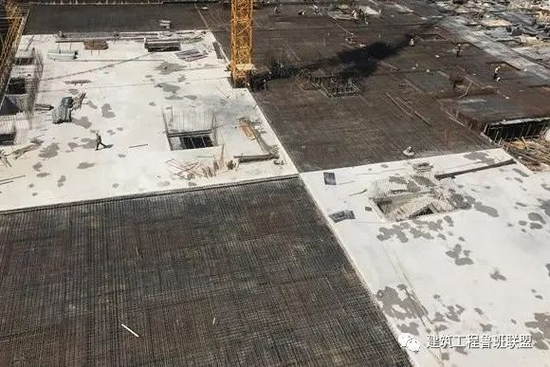
"alternative bay method" "alternative bay method" refers to the construction technology of alternative bay method for super-long and large volume concrete structure,
which means that in the construction of large volume concrete structure, in the early stage of large temperature shrinkage stress, the super-long concrete block is divided into several small blocks for interval construction. After a short period of stress release, a number of small blocks are connected into a whole in the later stage of small shrinkage stress, and the construction method relies on the tensile strength of concrete to resist the temperature shrinkage stress in the next stage. Example of
construction sequence of
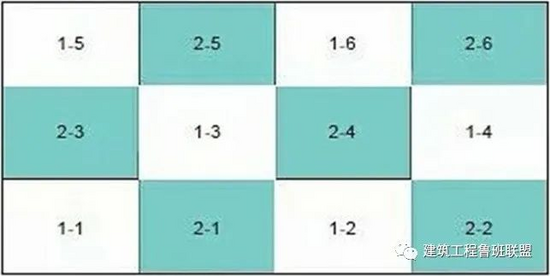
"bunker-skipping method" The construction process of "bunker-skipping method" is simple, and the example in the above figure is taken as an example:
according to the area of the foundation raft, it is divided into zones not more than 40 m along the length and width directions, and numbered along their respective directions. The specific construction sequence is as follows: first pour the first batch, i.e. 1-1 ~ 1-6, and then pour the second batch, i.e. 2-1 ~ 2-6, at an interval of not less than 7 days.
"Jumping method" makes full use of the principle of "resistance and release" that the internal stress of concrete is easy to release before its performance is not stable and it is not completely solidified during 5 to 10 days. It is constructed according to the principle of "block planning, block construction, layered pouring and integral forming". Its mode is the same as checkers, that is, pouring one section at a time. The interval between two adjacent sections shall not be less than 7 days to avoid the intense temperature difference and drying effect in the early stage of concrete construction, so that the post-cast strip is not required. The construction method of
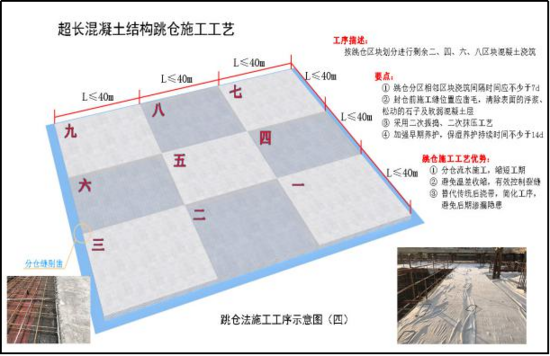
"
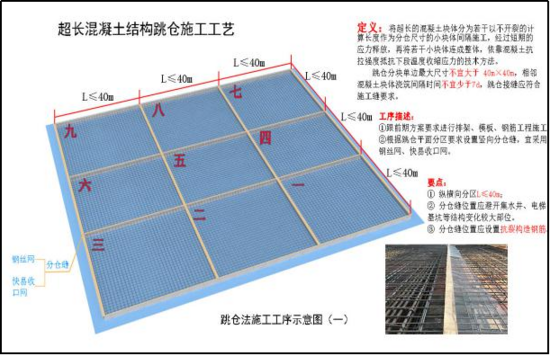
jumping warehouse
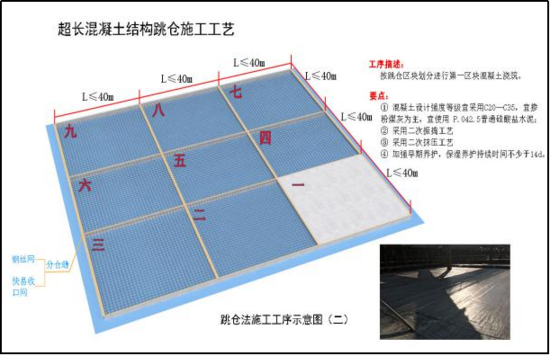
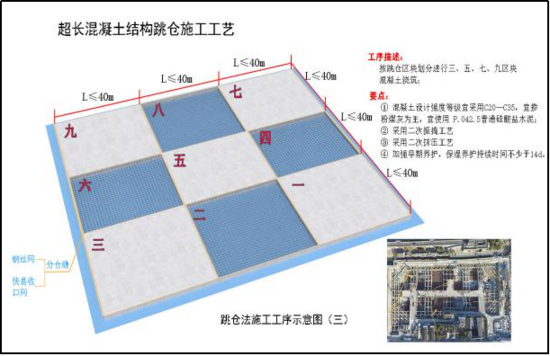
" has remarkable advantages compared with the traditional construction technology of "post-pouring belt":
1) simplifying the construction work It can speed up the construction progress.
2) Reduce construction joints, which is conducive to controlling cracks and improving project quality.
3) Material saving and environmental protection. The following problems should be paid attention to in the construction of
"alternative bay method":
1) Because the foundation slab belongs to mass concrete, the design strength grade of concrete should be C25 ~ C40, and the strength index of 60d or 90d can be used as the design strength of concrete.
2) The alternative construction method can also be used for the external wall of the basement, and the length of the area should not be more than 40 m. A 800mm post-cast strip can also be set along the 30-40 m of the external wall, and the two sides of the strip are made of reinforcement mesh or steel mesh. The post-cast strip can be poured synchronously when the concrete is poured on the roof, and it should not be less than 7 days.
3) The roof of the basement and the floor on the ground can also be constructed by the alternative construction method. The longitudinal and transverse planes are divided into zones that should not be greater than 40 m and numbered along their respective directions. Each floor and foundation slab (including the wall) need not be in the same span, but can be divided into zones (that is, the construction joints need not be aligned up and down).
4) When the alternative construction method is adopted, the requirements of relevant specifications must be strictly observed and met.
5) The floor slab can also adopt the alternative construction method, which is the same as the construction method of the foundation slab. Considering the thin thickness of the floor slab, the pouring interval can be shortened accordingly. In fact, there has been experience in this respect in the past sectional flow process.



 浙公网安备33010802003254号
浙公网安备33010802003254号